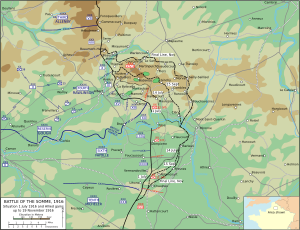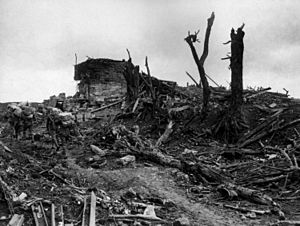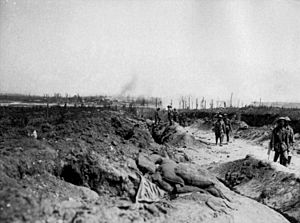Battle of Pozières facts for kids
Quick facts for kids Battle of Pozières |
|||||||
|---|---|---|---|---|---|---|---|
| Part of the Battle of the Somme during the First World War | |||||||
 Battle of the Somme 1 July – 18 November 1916 |
|||||||
|
|||||||
| Belligerents | |||||||
| Commanders and leaders | |||||||
| Strength | |||||||
| 12 divisions | |||||||
| Casualties and losses | |||||||
| I Anzac Corps c. 23,000 | |||||||
The Battle of Pozières was a tough fight that happened in northern France. It took place around the village of Pozières from July 23 to September 3, 1916. This battle was part of the larger Battle of the Somme during World War I.
The fighting was very difficult and resulted in many losses. In the end, British forces took control of the high ground north and east of the village. This gave them a good spot to threaten the strong German position at Thiepval from behind. An Australian historian, Charles Bean, later wrote that Pozières ridge was a place where many Australian soldiers fought and were lost.
Contents
Getting Ready for Battle
The village of Pozières sits on a ridge along the road from Albert to Bapaume. This ridge was right in the middle of the British battle area on the Somme. Near the village was the highest spot on the entire battlefield. This high point was important because even a small hill helps soldiers see better for their artillery (big guns).
Pozières was a key German defense spot. It was like a guard post for their second line of trenches, which the British called the O.G. (Old German) lines. This German defense line stretched from Mouquet Farm in the north, went behind Pozières to the east, and then south towards the Bazentin ridge. On July 14, during the Battle of Bazentin Ridge, the British Fourth Army captured the southern part of this German line. If Pozières could be taken, the British might be able to attack the German second line from the side.
The British Commander-in-Chief, General Sir Douglas Haig, didn't have enough artillery shells for another big attack right away after July 14. Haig believed that Pozières and Thiepval would become too hard for the Germans to hold as the British moved east. So, he told Rawlinson to focus on the middle area between High Wood and Delville Wood, and the villages of Guillemont and Ginchy. The plan was to keep up the pressure and take Pozières with a slow, careful, step-by-step attack. Between July 13 and 17, the Fourth Army made four small attacks on Pozières. These attacks failed with many losses. During this time, the village was heavily bombed and turned into ruins. Twice, the attacking soldiers got into the trench around the village, known as "Pozières trench," but they were forced out both times. Trying to move east of the village along the O.G. Lines also didn't work.
The Battle Unfolds
Taking Pozières Village
General Rawlinson planned another big attack for July 18. Six different army divisions would be involved, fighting between the Albert–Bapaume road in the north and Guillemont in the south. General Haig decided to give the job of taking Pozières to the British Reserve Army, led by Lieutenant General Hubert Gough. This army had been holding the line north of the road since the start of the offensive on July 1. The attack was delayed until the night of July 22–23.
Gough's army was joined by three Australian divisions, known as I Anzac Corps. They had moved from the Armentières area. The Australian 1st Division arrived in Albert on July 18. Even though the main attack was delayed, General Gough, who liked to push forward, told the division's commander, Major General Harold Walker, "I want you to go in and attack Pozières tomorrow night." Walker, an experienced officer, refused. He insisted on attacking only after proper preparations. So, the attack on Pozières was again set for the night of July 22–23, along with the Fourth Army's attack.
The plan was for the Australian 1st Division to attack Pozières from the south. They would advance in three stages, each half an hour apart. North of the Albert–Bapaume road, the 48th (South Midland) Division would attack German trenches west of the village. The village and nearby area were defended by parts of the 117th German Division. On July 22, the Australian 9th Battalion tried to improve its position by moving towards the road along the O.G. Lines, but they were pushed back.
Before the main attack, the village and O.G. Lines were heavily bombed for several days. The bombing included phosgene and tear gas. The soldiers were set to attack at 12:30 a.m. on July 23. The Australian 1st and 3rd Brigades crept into no man's land, close behind the bombs. When the bombing stopped, they rushed the German trenches. In the first stage, they took the Pozières trench that circled the village to the south.
In the second stage, the Australians moved to the edge of the village, among the ruined back gardens of the houses along the Albert–Bapaume road. The third stage brought their line to the Albert–Bapaume road. The few German soldiers who survived retreated to the northern edge of the village or into the O.G. Lines to the east. The plan also included capturing the O.G. Lines up to the road, but the Australians failed here. This was partly because of strong resistance from Germans in deep dugouts and machine gun nests. It was also due to the confusion of a night attack on ground that was hard to recognize. Weeks of bombing had turned the ridge into a field of craters, making it almost impossible to see where a trench had been. Because they didn't take the O.G. Lines, the eastern part of Pozières was left open. So, the Australians formed a new defense line short of their goals. On the western edge of the village, the Australians captured a German bunker called "Gibraltar". On July 23, some Australians explored across the road, captured several Germans, and easily took more of the village. That night, the 8th Battalion of the Australian 2nd Brigade, which had been in reserve, moved up and secured the rest of the village. The 48th Division's attack on German trenches west of Pozières had some success. However, the main attack by the Fourth Army between Pozières and Guillemont failed with heavy losses.
Defending Pozières
Winning battles on the Somme often came at a very high price. For the Australians, Pozières was one of those times. Because it was the only British gain on July 23, Pozières became a main target for the Germans. It was a critical part of their defense, so the German command ordered it to be taken back at all costs. Three attempts were made on July 23, but each was stopped by British artillery or machine gun fire.
Communication was hard for both sides. It wasn't until 7:00 a.m. on July 24 that the Germans found out Pozières had been captured. With less British activity elsewhere, the German IV Corps facing Pozières could now focus most of its artillery on the village and its approaches. At first, the bombing was steady and non-stop. The western road into the village, from Casualty Corner, was bombed so heavily that it became known as "Dead Man's Road." The German bombing got even stronger on July 25, as they prepared for another counter-attack.
The German IX Corps replaced IV Corps. Their commander canceled the planned counter-attack. He chose instead to focus on defending the O.G. Lines, which were the next British objective. The bombing reached its peak on July 26. By 5:00 p.m., the Australians thought an attack was coming and asked for their own artillery to fire back. The artillery of I Anzac Corps, II Corps, and guns from two nearby British corps fired in response. This made the Germans think the Australians were preparing to attack, so they increased their fire even more. The shelling didn't stop until midnight. At its worst, the German bombing of Pozières was as intense as anything seen on the Western Front. It was far worse than any shelling an Australian division had faced before. The Australian 1st Division had 5,285 soldiers killed or wounded during its first time fighting at Pozières. When the survivors were replaced on July 27, one person said they looked like "men who had been in Hell... drawn and haggard and so dazed that they appeared to be walking in a dream."
The O.G. Lines (Old German Lines)
On July 24, after Pozières was secure, General Gough pushed for immediate attacks on the O.G. Lines north and east of the village. The first goal was to take the lines up to the Albert–Bapaume road, which were the original objectives that hadn't been captured. Attacking in the dark, only the Australian 5th Battalion found either of the O.G. trenches. They were then counter-attacked by the German 18th Reserve Division. At the same time, on the Australians' right, the British 1st Division tried to capture Munster Alley. This was a section of the Switch Line where it met the O.G. Lines. A chaotic bomb fight broke out, but only a small part of the trench was held.
Before it was pulled out, the Australian 1st Division tried to prepare a starting line for the attack on the O.G. Lines. The Australian 2nd Division took over the area on July 27. General Gough, eager for progress, pushed for an immediate attack. The division's commander, General Gordon Legge, was less experienced than General Walker and gave in to Gough's pressure. On the night of July 28–29, the 2nd Division was expected to attack. The conditions were much worse than what the 1st Division faced on July 22–23. The constant German bombing made good preparations almost impossible. Dust from the shelling stopped Australian artillery observers from guiding their field guns, which were supposed to cut the barbed wire fences.
An attack by the British 23rd Division on Munster Alley pulled in the Australian 5th Brigade. In the bomb fight that followed, British and Australian soldiers used over 15,000 grenades. The main attack went ahead, set for 12:15 a.m. on July 29. But the Australian 7th Brigade was late getting to its starting line, and the German defenders noticed their movement. When the attack began, the Australians were met by a storm of machine gun fire. South of the road, the 5th Brigade was stuck, unable to even start. On their left, north of the road, the 7th Brigade found uncut wire. On the northern side, the 6th Brigade made some small progress, but everywhere else, the attack failed. Including the attack and the day of preparation before it, the 2nd Division lost over 3,500 men. The 7th Brigade had to be pulled back to reserve because its losses were so high.
General Haig was critical of the division's failure. He told Lieutenant General William Birdwood, the I Anzac Corps commander, "You're not fighting Bashi-Bazouks now." General Legge and the I Anzac staff decided to do the job properly. To avoid confusion during a night advance, the plan was to attack at 9:15 p.m., just before dark. At that time, the top of the ridge and the mound of the Pozières windmill would still be visible. However, attacking at dusk meant gathering during the day, which was only possible in the safety of trenches. So, a system of approach and assembly trenches had to be dug at night. Whenever the Germans saw digging parties, they thought soldiers were gathering to attack and called down heavy bombing.
Originally, the attack was set for dusk on August 2, but the trenches were not yet finished. The digging was either stopped or the completed trenches were destroyed by shelling. The attack was first delayed to August 3, and then to August 4, when the trenches were finally ready. This careful planning and preparation led to success. When the 2nd Division attacked, both O.G. Lines were captured. South of and across the Albert–Bapaume Road, the O.G. Lines had been so completely destroyed by long shelling that the Australians ended up moving past their goals. From their new position in the O.G. Lines on the eastern edge of the Pozières ridge, the Australians could now see green countryside. The village of Courcelette was close by, and the woods around Bapaume were about 5 miles (8 km) away. The German commander ordered, "At any price Hill 160 Pozières ridge must be recovered."
Final German Counter-Attack
By August 5, the brigades of the 2nd Australian Division were very tired. They were to be replaced by the 4th Australian Division. While the changeover was happening on the night of August 5–6, the Australians faced extremely heavy bombing. This was because the area they held could be shelled by the Germans from all directions, even from Thiepval, which was behind them. On the morning of August 6, a German counter-attack tried to reach the O.G. Lines. But they were met by machine gun fire and forced to dig in. The bombing continued all day. By the end of the day, most of the 2nd Division had been replaced. From its twelve days in the line, the division had 6,848 soldiers killed or wounded.
At 4:00 a.m. on August 7, just before dawn, the Germans launched their final counter-attack. On a front of 400 yards (370 m), they overran the lightly held O.G. Lines. They caught most of the Australians in shelters in the old German dugouts and moved towards Pozières. For the Australians, this was a critical moment. At this time, Lieutenant Albert Jacka, who had won the Victoria Cross at Gallipoli, came out of a dugout. He and seven men from his platoon had been cut off. Jacka charged the German line from behind. His brave example inspired other Australians scattered across the plateau to join the fight. A fierce, hand-to-hand battle began. Jacka was badly wounded, but as help arrived from the sides, the Australians gained the upper hand. Most of the surviving Germans were captured. After this, no more attempts were made to retake Pozières.
What Happened After
Casualties
In the fighting around Pozières, the 48th Division had 2,700 soldiers killed or wounded from July 16–28, and 2,505 more from August 13. The 1st Australian Division lost 7,700 men. The 2nd Australian Division had 8,100 casualties, and the 4th Australian Division lost 7,100 men. From July 27 to August 13, the 12th Division had 2,717 casualties.
Victoria Cross Heroes
The Victoria Cross is the highest military award for bravery in the British and Commonwealth armed forces. Several soldiers earned this award during the Battle of Pozières:
- Private Thomas Cooke from the 8th Battalion, 2nd Brigade, 1st Australian Division.
- Private John Leak from the 9th Battalion, 3rd Brigade, 1st Australian Division.
- Lieutenant Arthur Blackburn from the 10th Battalion, 3rd Brigade, 1st Australian Division.
- Sergeant Claud Castleton from the 5th Machine Gun Company, 5th Brigade, 2nd Australian Division.
See also
- Order of battle for the Battle of the Somme
- Pozières Memorial: This memorial is not just for the battle itself. It includes a Commonwealth War Graves Commission cemetery where many of those killed during the battle are buried, including Claud Castleton, VC.



